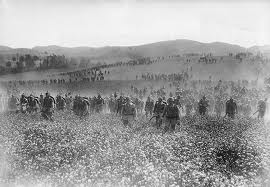I have been in correspondence with Elizabeth Morgan of www.churchlinens.com who sent me a most interesting article. We were discussing linen, and she being an expert in the field, enlightened me on an aspect of both World Wars which I had never considered, and that is, that the resultant destruction of the lowly flax flower fields of Europe greatly impoverished what had been the traditional and proper vestiture for sacerdotal service ever since biblical times.
Leviticus 16:4: “He shall be vested with a linen tunick, he shall cover his nakedness with linen breeches: he shall be girded with a linen girdle, and he shall put a linen mitre upon his head: for these are holy vestments.”
Ezek. 44:17: “And when they shall enter in at the gates of the inner court, they shall be clothed with linen garments.”
“Because our use of linen – and cotton – was such a basic part of life, the skills and techniques were passed experientially from generation to generation. So much was never written down.
“And then, the two World Wars destroyed the European flax fields … Except for linen fabrics that had been stockpiled by importers, there was no linen to be had – at all. And, just at that time, enter rayon – stage left. And then, the polyesters and ‘Perma-Press’. And, with these new fabrics available, we went right on – without linen.
“The experiential knowledge died with the next generations – and very little had been written down.”
Here is a document Elizabeth sent me on the subject which is quite interesting:
FABRICS: A POST-WAR CHAPTER 1947
(By Lucy Vaughan Hayden Mackrille, first Altar Guild Directress of the National Cathedral at Washington, DC. Taken from the second edition of her book; Church Embroidery And Church Vestments, copyright 1939.)
This book is a pre-war composition. Sad changes have come over the textile industries of the world. With tears we handle the lustrous and luminous folds of the luxuriant fabrics of years now gone. It is difficult to contemplate Church life without them. Those were golden days and we did not know it.
We are emerging from a devastating war; which necessitates the revision of my chapter of Silk Fabrics. The precious silks I wrote about on page 19 are no more. The English 27-inch damasks we loved so much are gone perhaps forever. They have been destroyed by bombs and fire. The very looms and machines, the patterns and designs are gone, destroyed, obliterated. There is no more silk thread to weave; even if we had the looms to weave it. No more silk thread to make embroidery silks, nor to make the shining cords and twists, and luscious fringes. All silk thread came from Japan. And now they talk of cutting down the mulberry trees which feed the silk worms; so they can plant gardens to feed the starving Japanese people.
With the destruction of the English silk industry, silk textile workers in the United States undertook to weave a 50-inch width silk damask, copying the English registered, patented designs, Ely, Agnus Dei, and Small Rose (my italics), as long as the silk thread lasted, and until the U.S. Government commandeered all there was left, for the U.S. Forces, parachutes, etc.
These silk damasks, U.S. Make are excellent and the width is most acceptable, reducing the number of seams in a superfrontal, for instance. But now the meager supply of silk is no more; and the synthetic fabrics do not compare favourably. A few years ago a silk industry was established in Canton, China. Now that Japan has evacuated Canton there is no hope for the restoration of this infant silk industry.
Gold thread is gone too. Japan made all the untarnishable gold thread. Whether we ever see any more is a question. These may again come to our shores if Japan can get ships.
Cloth of gold is no more. That was largely made in Europe, especially France; but those factories not destroyed by bombs have been stripped of every scrap of machinery. Nothing is left, nothing. France has no silk thread, no cotton thread, no looms, no machines, no tools, no man power.
There is no more linen being made; nor has been since the war began. The best flax, the long fibre flax, came from the Ukraine in Russia. The Germans burned over these plains, destroying the very fertility of the soil. Linen must be woven in a wet country – some place like Ireland, where it rains every day. So now we are waiting for Russia to rehabilitate her flax fields, so that Belfast’s linen industry may be resumed.
Commerce is being restored. We live in hope. Be very careful of linen vestments, and the Altar linens; washing them at home, never at a public laundry. Be careful of the silk vestments, keeping them shut up away from dust and light, when not in use.
++++++++++++++++
Little by little we are seeing a return to beauty and tradition in the Church’s liturgy – in her total ambiance, actually. This includes of course, a return to the use of natural fibers, first and foremost being the fibers of the lowly flax flowers.
Don’t the colors of these humble, little flax flowers remind you of our Lord and of our Blessed Lady?




